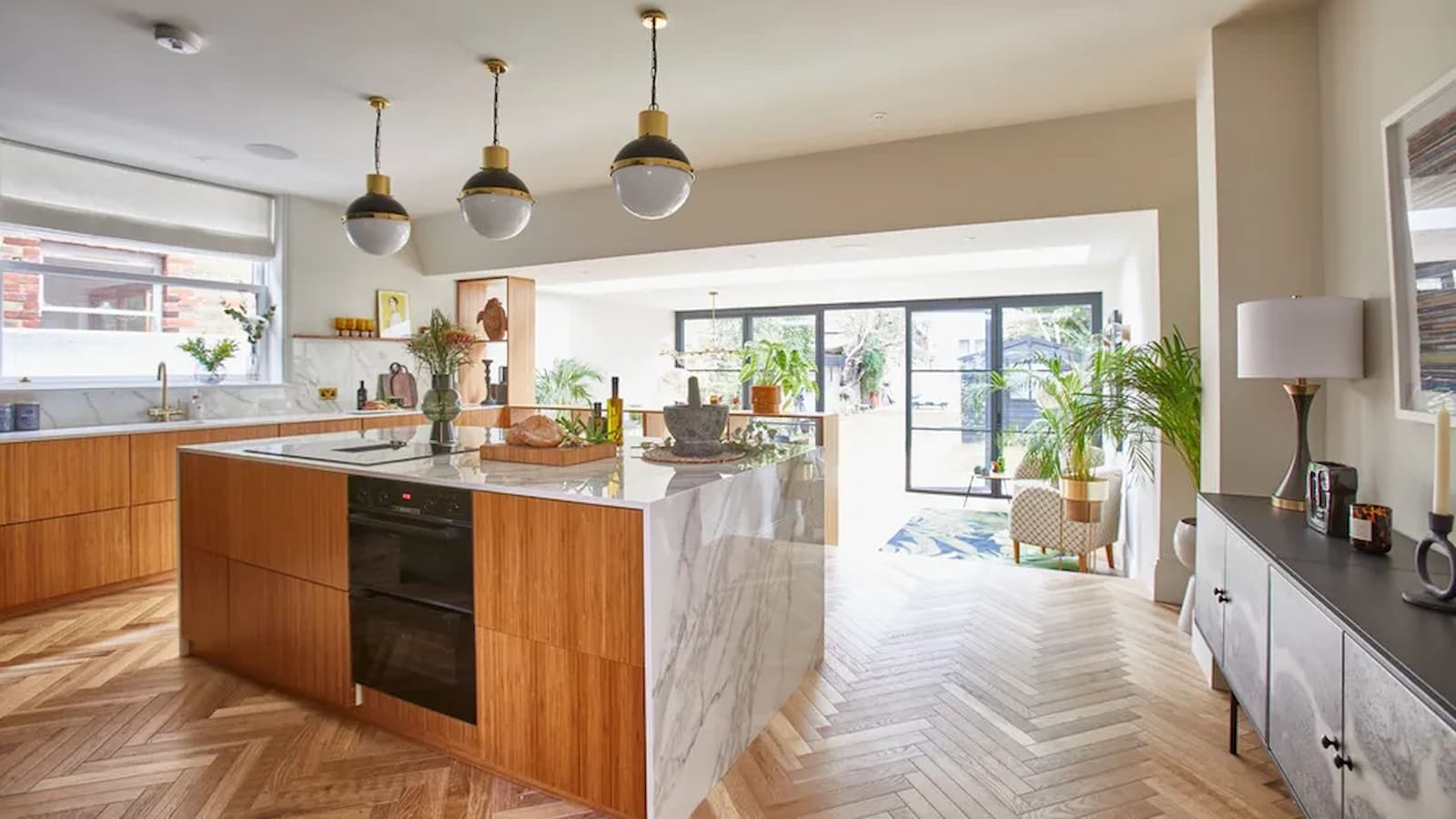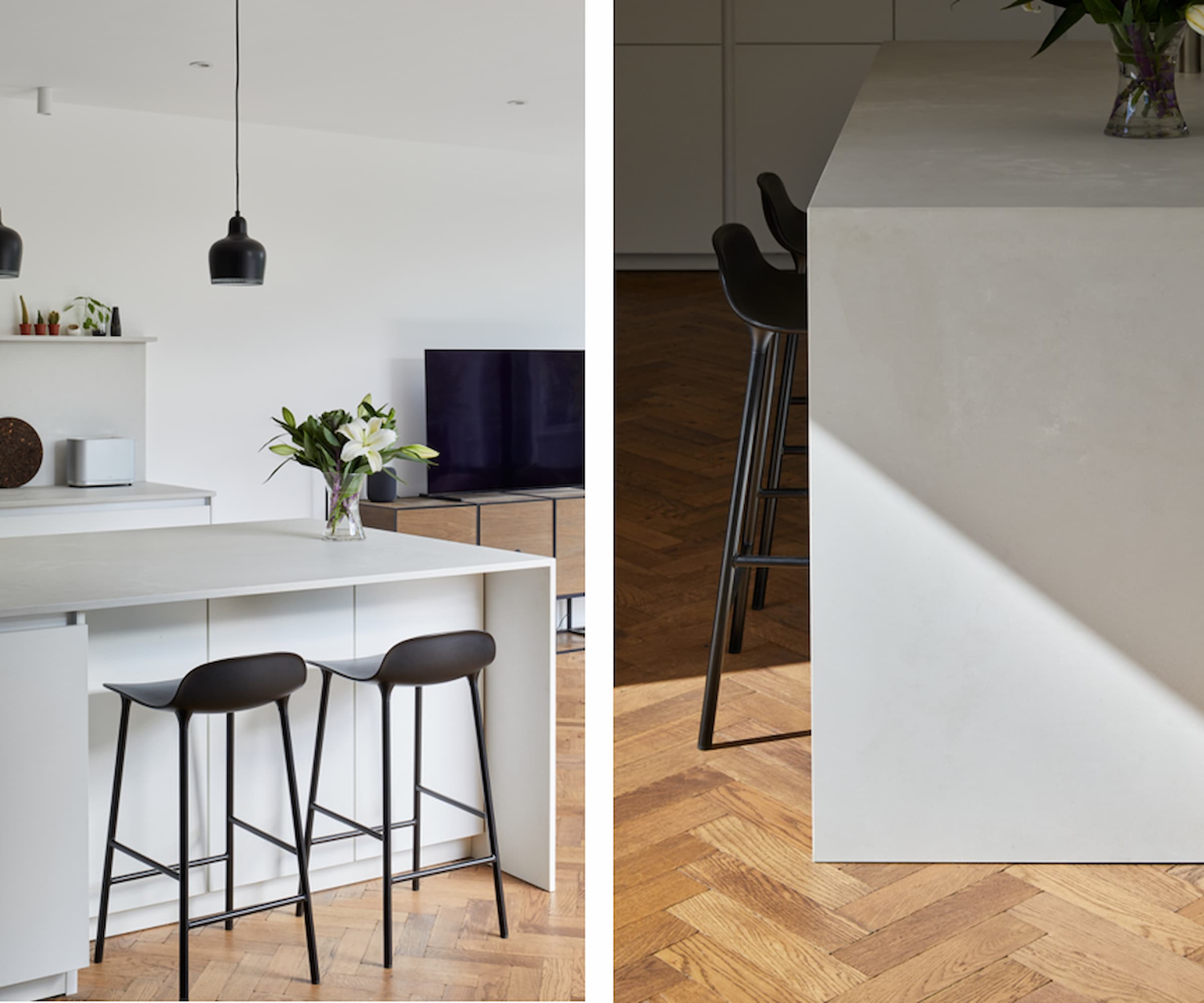What is a waterfall worktop? Plus how to pick the right one for your kitchen
Explore how waterfall worktops can transform your kitchen with a sleek, continuous design that combines style and practicality

Waterfall worktops have become a defining feature in modern kitchen design, celebrated for their seamless, striking look.
By extending kitchen worktops vertically down the sides of an island or cabinetry, they can help create a dramatic, continuous surface.
While eye-catching, they also come with practical considerations and a higher price tag. In this guide, we delve into the pros, cons, and tips for choosing a waterfall worktop to help you decide if it’s the right choice for your kitchen.
What is a waterfall worktop?

A waterfall worktop is a modern and sophisticated design feature commonly seen in kitchens, particularly on kitchen islands.
Jonathan Stanley, VP of marketing at Caesarstone, describes a waterfall worktop as a "striking island feature" where the kitchen countertop extends vertically at a 90-degree angle.
This design creates a continuous surface from the countertop down the side of the cabinetry. Stanley states waterfall worktops are typically made from materials like quartz as it allows for a smooth, uninterrupted flow.

Jonathan Stanley is a seasoned marketing and communications leader with over 20 years of experience shaping strategies for brands in the kitchen design and home improvement sector.
What are the pros and cons of waterfall worktops?

“One of the biggest advantages of a waterfall kitchen island is its sleek and modern aesthetic,” claims Molly Chandler, designer at Willis & Stone. “The seamless flow of the countertop material cascading down the sides creates a striking focal point in the kitchen. It’s visually stunning and also practical, offering additional countertop space for meal prep, dining, or socialising.”
However, she notes there are some challenges to consider. “The cost can be a downside, as waterfall islands require more material and precise installation compared to traditional worktops,” Chandler explains. “This increases both the complexity and the expense of the project.”
Another consideration is durability. “The continuous surface of a waterfall island is more susceptible to chips, scratches, or stains. Regular maintenance is essential to keep it looking its best,” she advises.

Molly Chandler is a designer with a wealth of experience in creating quality kitchens to suit a wide variety of customer needs. From initial idea through to completed design, Molly understands just how to make a kitchen perform on a practical and aesthetic level.
How to choose a waterfall worktop

When choosing a waterfall worktop, Stanley emphasises the importance of selecting the right material to achieve the desired effect.
"The goal is to make the entire design appear as though it’s made from one continuous slab." He says this is especially challenging with natural materials like marble or granite, as the natural veining can cause mismatched patterns, disrupting the seamless look.
However, Stanley points out that waterfall worktops are specifically "designed and engineered carefully," which allows for a cohesive and uninterrupted flow.
How much does a waterfall worktop cost?
Chandler emphasises the need for budget planning. “A waterfall worktop can cost anywhere between £3,000 and £8,000, depending on the quartz product you choose,” she says.
“Because they require multiple quartz slabs, they can significantly increase the overall cost of a kitchen project. This makes them less suitable for those on a tight budget.”
What are some design tips in making a waterfall worktop?
For those looking to integrate a waterfall worktop into their kitchen design, Chandler offers some valuable advice. “I always recommend including seating beneath a waterfall island,” she says.
“This design choice accentuates the shape of the quartz from multiple angles and creates interesting contrasts of light and shadow. It adds depth and visual interest to the kitchen."
Are there any practical considerations that need to be known?
Chandler stresses the importance of structural support for these stylish features. “A quartz waterfall island requires a lot of support,” she explains.
“You’ll need sturdy cabinetry underneath to hold the structure. Quartz tops can only overhang up to 400mm from the cabinetry, so if you’re including seating space, you’ll need either reduced-depth cabinets or a bridging support to ensure the stone is properly supported”, she added.
Waterfall worktops can transform a kitchen into a design masterpiece, but they’re not without their challenges.
From selecting the right material to balancing cost and practicalities such as the ideal kitchen worktop height, there’s a lot to consider.
Whether you’re captivated by their sleek appearance or concerned about the investment, understanding the full picture will help you make an informed decision about this standout feature.
Shop kitchen extractor fans
Get the Homebuilding & Renovating Newsletter
Bring your dream home to life with expert advice, how to guides and design inspiration. Sign up for our newsletter and get two free tickets to a Homebuilding & Renovating Show near you.

News Editor Joseph has previously written for Today’s Media and Chambers & Partners, focusing on news for conveyancers and industry professionals. Joseph has just started his own self build project, building his own home on his family’s farm with planning permission for a timber frame, three-bedroom house in a one-acre field. The foundation work has already begun and he hopes to have the home built in the next year. Prior to this he renovated his family's home as well as doing several DIY projects, including installing a shower, building sheds, and livestock fences and shelters for the farm’s animals. Outside of homebuilding, Joseph loves rugby and has written for Rugby World, the world’s largest rugby magazine.



